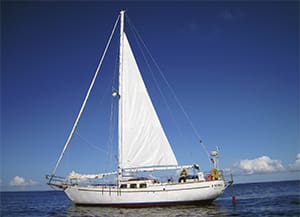The Bay of Biscay has a notorious reputation for bad weather. The authoritative book Heavy Weather Sailing, by Adlard Coles, was largely based on the experiences of yachtsmen in the benighted bay. I recently crossed the Bay of Biscay with two crew in my sturdy and well-traveled Westsail 42 Fiona and found it to be as challenging a body of water as ever.
I suspect the severe sea conditions sometimes encountered in the Bay are caused by the 250-mile-wide entrance that faces west towards the 3,000-mile fetch of the North Atlantic. I had my own baptism of the nasty side of the bay in 2004 when I made a double-handed crossing from Falmouth to Lisbon. When we arrived in the Tagus River with the jib hung in tatters off the headstay, we looked so bedraggled that a police launch inquired if we needed assistance!
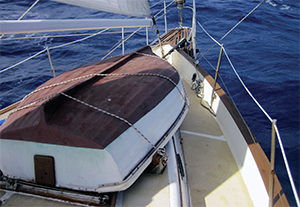 |
|
Fiona’s dinghy in its “at sea” position above the forward hatch. |
My latest venture along the same route was timed for the middle of Fiona’s 2015-2016 cruise. We left Long Island, N.Y., in July 2015 and sailed via New England and Nova Scotia to St. John’s, Newfoundland. From there, a 16-day crossing of the North Atlantic took us to Oban on the west coast of Scotland. We enjoyed a pleasant cruise of the Western Isles before transiting the Caledonian Canal and landing in Denmark. After more delightful cruising in Denmark, Sweden and Germany, we sailed down the Kiel Canal to the North Sea and on to Falmouth via the English Channel.
For various reasons, mostly due to crew scheduling, I was a little late leaving Falmouth; it was Nov. 12 before I was able to push off with a crew of two. Steve was an engineer who had retired a few months earlier and was wondering if a cruising life was for him; Gus was a teenager who had just obtained an RYA Competent Crew Certificate. Neither Steve nor Gus had any deepwater sailing experience. In order to appreciate what was to befall us, a few words about Fiona: She is a cutter-rigged sloop, 42 feet overall with a 4-foot-long bow platform forming a heavy bowsprit. Fiona carries a yankee jib, high cut on a roller furler. The self-tending staysail is fastened to a short boom pivoted at the foot of the forestay. The mainsail I chose for this crossing was a storm sail, about the size of a regular main with one reef tied in, carrying two deep reefs.
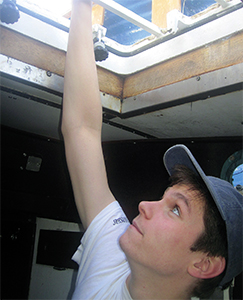 |
|
Crewmember Gus demonstrates that the transparent forward hatch panel has disappeared. |
Increasingly heavy seas
On the morning we left, the wind was forecast to be southerly at 20 knots veering to westerly later. I figured this would do nicely to get us to Land’s End and then provide a slant for us to head southwest to clear Ushant. We powered past Lizard Point and set the main in rough seas with the first reef tied in. To my surprise, as we bashed past the Cornish coast the new crew were not seasick — a good omen. We weathered Land’s End in increasingly heavy seas. I aimed to pass north of the Isles of Scilly, but after we passed south of the Seven Stones the wind began to back and I realized we would not clear the western end of the archipelago. So I turned the boat around and reached to the eastern end of the Isles of Scilly. This maneuver wasted a few hours.
Once in the approach to the Channel, we began a series of tacks, keeping a careful eye on our position relative to Ushant. The boat was steered by “Victor,” the name I gave long ago to the Aries wind vane. The wind was blowing a fresh gale. Once a day I started the engine to keep the batteries fully charged and cool the freezer. Unfortunately on the second day the starter key stuck in the “on” position, unnoticed by any of us due to the noise of the rough seas. Later the characteristic smell of burning insulation permeated the main cabin; the starter would have to be replaced if we wanted to run the engine again.
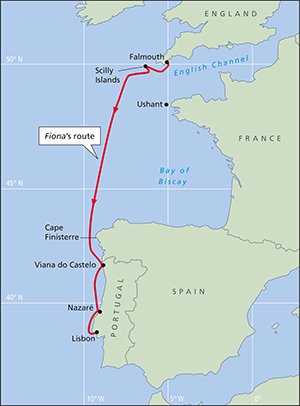 |
|
Fiona’s route, about 1,000 nm sailed to make good 700 nm from Falmouth to Portugal. |
Reefing and unreefing
By late on Nov. 14, we had reached 49° 04’ N, 07° 17’ W and I judged we could lay a direct course for Cape Finisterre without getting into the maw of Biscay. The next day we sailed on starboard tack, reefing and unreefing as the wind varied between 22 knots and 35 knots, with gusts to 40. At 0230 on Nov. 16, I decided to shake out a reef in the mainsail; the cleats for the slab reefing lines are all on the port side of the boom, so this job is best done on port tack. The sea state was far too rough to tack without an assist from the engine, which was still defunct, so we had to gybe. After a quick briefing Gus handled the jib sheets, Steve took the main sheet and I stood at the wheel. With a yell of “Gybe-Oh” I put the wheel over. The sails shivered and with an unnerving crash the boom went over — the main sheet was not hardened up as much as it should have been and Steve collapsed onto the cockpit grating, holding his hands to his face. In the light of my flashlight I saw blood oozing between his fingers; the loose sheet had caught him across his face, knocking out a tooth. We cleaned him up and put him in his bunk. Steve was very chipper after a night’s rest but in considerable pain. I kept him on a steady diet of Aleve for the rest of the trip. I was very chagrinned that Steve had been hurt — gybing a boat in a high wind at night is taxing enough even for an experienced crew. I should have waited for daylight.
In morning I felt it was essential to get the engine back in service, although sea conditions were very rough. I removed the starter and installed a spare with Gus assisting by passing tools and holding the nuts and bolts I had unscrewed (see sidebar).
For the next couple of days the wind howled from the southwest in the range of 30 to 35 knots with short, steep waves. The boat pounded badly, far worse than I had ever experienced, even in Buzzard’s Bay. The forward head took a beating, resulting in broken door latches, drawer supports torn from the tabbing to the hull and there was worse to come. But as the wind veered slightly we were able to hold the rhumb line course to Cape Finisterre on starboard tack. When enduring heavy weather, it is always good to know that at least you are going in the right direction.
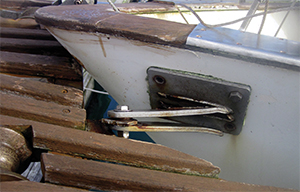 |
|
Weld failure of the portside bow platform mounting bracket. |
A cascade of water
I was standing in the swaying main cabin when I glanced through the open door of the forward head. A cascade of water suddenly splashed down from the overhead hatch, which was supposed to be dogged down tight. I went forward to fix it, but it was dogged. As I tried to figure out just what was going on, more water suddenly splashed down — that seemed impossible. I put my hand to the clear plastic panel in the hatch and found I was reaching up to the underside of the rigid dinghy mounted over the hatch. The plastic insert of the hatch had disappeared. Fiona had a 2-foot square hole in the coachroof of the forward cabin through which a torrent poured in whenever we took green water over the bow. I had pieces of plywood for just such an emergency, but I could think of no way of fastening a piece over the hole on the outside without moving the dinghy — a practical impossibility in the current sea state. I just made sure the forward bilge pump was functioning properly.
As we approached Cape Finisterre, a few freighters passed us going north. We were crossing a sea lane. By Nov. 20 we had weathered the Cape and we swept down the coast east of the lane. The wind veered and increased to 30 knots with much higher gusts, a common phenomenon near large capes. To keep the boat balanced, we tied the second reef in the mainsail. For the first time since we left Falmouth, we were sailing free with control over the course. The jib had been furled for some time — very fortunate as it happened. On Nov. 21 we rounded the massive jetty at Viana do Castelo and tied up in the tranquil marina by lunchtime. We had sailed a little more than 1,000 sea miles since leaving Falmouth.
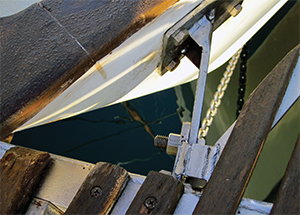 |
|
A new bracket was made from 10-mm thick material instead of the original 6 mm. |
It had been a rough ride, but just how much damage the boat had suffered was not obvious until I inspected the bow platform. It felt “spongy” under my feet, and to my horror I found that three of the four stainless steel brackets holding the platform to the hull had fractured. The platform was literally prevented from leaving the boat by the headstay and bobstay.
After a few days at Viana, making numerous fairly minor repairs such as the forward hatch, we gingerly powered down the coast to Nazaré, where I knew from previous visits that the large fishing fleet based there supported numerous repair shops and there was a yacht-friendly marina. Alec Lammas and his gang descended on the boat, removed the platform, designed and fabricated new brackets and had us ready to go in four days of work. We moved on to Cascais, near Lisbon and the crew dispersed. I flew home to New York for Christmas and returned with a duffel bag full of spare parts and fittings to prepare the boat for the next leg to the Caribbean.
Eighty-four year-old Eric Forsyth has been cruising the world’s oceans for more than 50 years, sailing more than 300,000 sea miles. He has circumnavigated twice; once in each direction and has traversed the Northwest Passage. He has rounded Cape Horn four times, three downwind and one upwind. Captain Forsyth was awarded the Blue Water Medal by the Cruising Club of America in 2000 for a voyage he made to Antarctica. He is a contributing editor to Ocean Navigator magazine and has written many sailing articles over the years.

